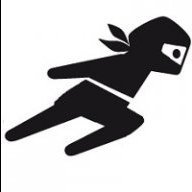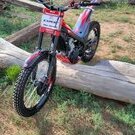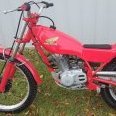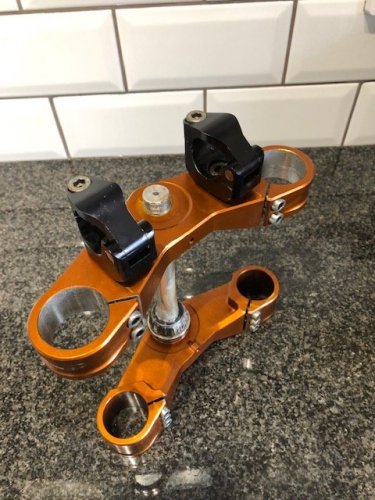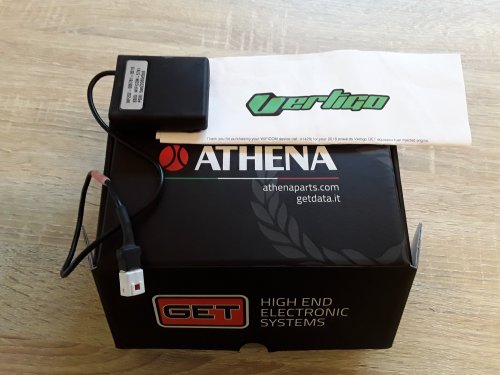All Activity
- Past hour
-
Any help, greatly appreciated... I'm struggling! I recently purchased a Honda RS200T twin shock. Unfortunately, a PO registered the bike with DVLA as manufactured 1985, when Honda only produced these from 1979-1981! Trying to correct this error, I've obtained proof (Dating Certificate), from Honda Owners Club (GB), confirming 1979 as YOM - Honda GB and Japan, weren't able to assist... but DVLA won't accept and are asking for more info! They've suggested an excerpt of the production record from Honda's worldwide database, amongst other things! Where could I locate that?!? I'm running out of ideas, clearly the bike has been incorrectly registered, but where to go next? Anyone able to assist... 🥺
- Today
-
I can only agree... We had the 80cc TRS not even a year. I thought it would be a killer bike in between 50/80cc beta and the bigger 125cc with the geometry and quality of the bigger TRS's. It was not... It broke down numerous times. Waterpump seal within the first hours mixing oil and coolant... great... Worst part was the casing that broke 4 times... Right hand side with the crack starting from the kickstarter. It would even break from my daugther starting the bike and she's a 10 year old. Then there's the engine's terrible running. We've tried different jet settings etc but it's a pain to get it running right and according to my daugther it runs and feels different every time. FRame, suspension, geometry are great! Engine sucks... Great shout out though to my TRS-dealer who solved all the problems as fast as he could with the factory backing him but we've have lost so many driveable hours last year. Eventually ( the little lady grew significantly last year) we switched to a 125rr. Way better. Avoid em if you can... Ride it out on the Beta 80 till they're big enough for a 125.
-
2025 TRRS ONE RR 80 (Identical to 2024) 3 month review: Short answer, Do Not Recommend. Avoid like the Plague. Despite its horrible geometry, I would recommend the Beta 80 big wheel for a child to grow into a 125. Long answer: The good: Geometry wise it is superior to the Beta 80 in every way, stable, predictable & puts power to the ground like a trials bike should. The front does get a little floaty on the steep climbs. The bad: Uses the same defective/sloppy k/start shaft/kicker interface the Beta uses. First thing I checked when I got it home, bolt was already loose. The easy, quick, temporary permanent fix is wrap the splines in teflon tape leaving a little over hanging the shaft end to fold over. Then carefully slide the kicker on making sure not to push the teflon tape forward. Then generously apply red loctite to the threads of the bolt & internal threads on the shaft. Tighten & let cure 24 hours. Don't worry about the red loctite being permanent, it will be loose again in no time. Repeat as needed. Pro tip: Always kick start in neutral, cold or hot, reduces # of kicks to start & lengthens intervals of refastening kick start. One of the best traits of the TRS since the first ONE was the easy interface of the air box to the frame/carb. My last TRS I could do it blind folded it was that easy. Not this time. Instead of creating a unique air box/carb boot to continue this tradition w/the 80, TRS simply had someone on the factory floor cutting a chunk off the stock boot w/a pocket knife. So now trying to install the tail section needs three hands & a full pocket of change for the swear jar. I have it down to two hands & half a pocket of change. TRS could correct this. This bike has unique part #s for the shorter frame, skid plate, frame spars & unique rad/fan/cdi interface. It wouldn't break the bank to have a unique carb boot too & it would be retrofittable. I would buy one. Even though I shouldn't have to. Primary downside to the missing 2 inches of wheel base is the compact engine compartment. Want to change the spark plug. Remove gas tank. Remove rad bolt. Fight w/folding the rad forward while trying to get the plug cap off which is contained conveniently by the fan. Now continue to fight w/the rad while trying to get a box end spanner on the plug. Don't forget your tooth brush to clean out the unfortunate well around the base of the plug which is full of dust/grime/flotsam/jetsam. Continue fighting the rad/fan while threading the extra long plug out of its home. Another pocket full of change in the swear jar. The really bad: All hours/rpms noted are as indicated by my highly accurate, made in the far east tach/hour meter. I should have test rode my shiny new toy at the dealer, I would have left it there. It doesn't run. Stone cold w/ choke will start/ run for maybe 10 seconds. Crank the idle up as high as 2500 rpm to keep it running but now the idle floats all the way to 5000, hangs, floats back down just sitting on the stand. Reset the idle to 2000 & blip the throttle to keep it running & attempt to ride it. Won't idle won't rev won't lug although strangely in 5th or 6th gear I can do slow circle/figure 8s w/rpms around 2000. Any attempt to roll on the throttle slow or fast is met w/face planting deceleration. I managed to do this gentle ballet for an hour on relatively flat terrain at which point I now have a leaking c/shaft seal, a wet but not yet dripping shift shaft seal & as a bonus a stripped shifter. The worst bad: Had I known I was paying premium dollars for a made in the far east knock off engine I would not have considered this bike. The best part of my Beta 80 was the engine excluding the kick start. It idled, ran, shifted like a dream. My 2015 Beta engine was the 03-17 KTM 65SX made in Italy, not sure if the 2025 Beta 80 engine is still coming from there since KTM is several generations past that now. The TRS uses a Roshine copy of the 03-17 KTM 85SX, specifically the 2012-17. Roshine chose to get creative instead of following the blueprints as provided. The KTM 85 uses the goofy tapered 28 spline interface for the shifter prevalent on KTM two strokes. See this link for what happens to some lucky KTM owners : https://www.thumpertalk.com/forums/topic/1239495-this-shifter-shaft-is-fkn-bs/page/3/ Roshine said hold my beverage & watch this. Their shifter shaft has 15 external splines & the shifter has 26 internal splines. To further improve on the original specifications, Roshine replaced the 6mm traditional bolt w/a 5mm socket head that is two threads too long for the too shallow internal 5mm threads. Now for what ever reason before I went for my maiden voyage I checked this bolt & it was tight, as in bottomed out internally but barely fastening the shifter. Temporary fix is using a 1/2 inch counter sink on the back side of now stripped shifter spline, removing the first 2mm of ruined spline. Add two or more thick washers under puny 5mm bolt along w/some green loctite on tapers & tighten enthusiastically. Allow 24 hours to cure & I had a shifter that lasted under gentle shifting until the permanent fix. Permanent fix was sourcing the factory correct shift shaft from 03-17 KTM 85SX on EBAY as well as ordering brand new original KTM shifter + seal & clutch housing gasket from my friendly local KTM dealer. To change this shaft out involves removing the clutch side housing & clutch pack as well as removing the rear brake pedal. Luckily my friend is a veteran red seal level power sports tech who works for burgers & beverages. Took him just over an hour to disassemble & reassemble. Not one penny in the swear jar. Found an extra problem while in there. There is a big flat washer on the shift shaft that was conical on disassembly. Checked the fiche & that is supposed to be flat. One big hammer blow later & back to stock. This eliminated the shaft slop (in/out) of roughly 3mm. To use the stock KTM shifter involves removing a 10mm chunk & rewelding as the bend of the TRS is different to clear the fly wheel cover. My new & improved shifter is tucked behind the cover, not traditional trials style but still works. Another creative flourish of Roshine is to replace a proper press fit barb for the gear box breather w/a cheap plastic elbow barb that just "sits" in the hole. Anyone who regularly goes in the water/mud & then pressure washes after is going to end up with muck in their box. See this helpful thread for the appropriate part & pictures of what I am talking about. https://www.thumpertalk.com/forums/topic/1402267-ktm-sx-85-2016/ This mod will require the small vent line which just happens to slide nicely into a short piece of the original vent line to adapt to the breather "top hat". The leaking counter shaft turned out to be the sprocket spacer that rests behind the c/s sprocket was pitted & ugly. I replaced this part w/a genuine KTM part but ran into a small discrepancy. The KTM part is .19mm shorter than the Roshine copy which allows oil to ooze past the little o ring. Next thickness up solved the difference but requires precise application of that big hammer to seat the circlip into its groove. Thanks to @AndréNL warning of jetting difficulties I expected to replace the PWK 28 w/a more appropriate sized carb. My riding elevation is between 2500 & 6000 feet. First I tried the Polini PWK 24mm. Upon installation my bike would now idle cold for about 20 seconds @ 1850 rpm then die. Stock jetting as delivered was 45/105 which seemed rich to me. I worked my way all the way down to a 35 pilot which gave me excellent fuel mileage but not so strong in the power department. I followed this w/a 21mm OKO. Jetting as delivered was 45/105 as well. Anything smaller than the 45 & it was unusable so 45 was my baseline. I dropped the main to a 100 & gave it a go. Still will only idle for 20 seconds cold @ 1850 rpm & then dies. Runs strong from 4000 to redline but I felt there was more. 48 pilot does the trick but fuel mileage is only equal to my 125 w/a properly running PWK28. I now have a bike that is rideable from 4000 to redline. It doesn't like to idle & from 2000 to 4000 is a blubbery/breathless unusable mess. Strangely, I can still ride tiny slow circles in 6th gear at 2000 rpm indicated. I am guessing it is actually higher revs being lugged down hence why it seems to run at that rpm. I have found this bike w/a tiny 420 9 tooth c/s sprocket like lots of chain tension. Like two fingers between the swing arm & tensioner. Any looser & the chain starts to "pile up" under engine breaking & makes an expensive & imminent failure sound. I have a 12 tooth JT on order to try to see if it still makes that racket for an experiment. The transmission is a crunchy, poorly shifting, stick in gear abomination. Think coffee can of nuts & bolts bouncing around in a steel barrel cartwheeling down the terraced benches at Machu Picchu. Ratios are goofy too. 1-4 seems normal enough but 5 & 6 are way too low. My Beta 80 had huge gaps from 4-5 & 5-6. I had to put a 10 tooth (from 11) front to use 5 & 6 or it just wouldn't pull my weight. The TRS pulls 6 fine on level ground which was helpful when the shifter stripped as I was in 6th gear. All the gaskets/seals/machined interfaces seem to leak/weep/ooze. Only on the upper parts of the engine which are visible. All joints/interfaces on the bottom of the engine facing the skid plate are clean & dry. Holds 450 ml of coolant, 100 ml more than the big bikes. 570 ml of gear box oil, no sight glass, no dip stick, just fill level screw. I mentioned the geometry as superior to the Beta 80 but the missing two inches of wheel base is noticeable in the ride overall. Compared to my 125 this TRS 80 feels slightly harsh or choppy. Besides the missing wheel base, to meet its price point, it also has less expensive suspension compared to the big RRs. It also comes w/Dunlop 803s. While I have seen 803s mentioned favourably, they are NOT equivalent to X11s; I really miss my X11s. You have been warned!
- Yesterday
-
If you can determine who manufactured the controller, perhaps they would sell you the tool? If the encoder is Hall-effect, there are a limited number of positions at which the rotor can "cog". I would not recommend it, but trial and error is a possibility. If the encoder is sin-cos, then there may be 256 to 4096 possible positions (depending on the resolution of the A/D converter). Obviously not amenable to a trial and error solution. If you have not already removed the encoder, it may be possible to replace just the temperature sensor (thermistor). In which case you would need a known good thermistor to measure its value or cannibalize a complete new encoder to get a thermistor.
- Last week
-
sproket started following Beta evo 300 2025
-
Got new,. 3 weeks ago.beta evo 300 2t. I have taken off flywheel weight. Now love it, it pulls the front wheel up in 3rd with no clutch action. Took clutch apart it had 2 steel drive plates side by side, doesn't seem right, Brought a year old 250 had same, so traded it in for the new 25 300. Very strange. Pressure plate scraped inside clutch cover, now sorted. Just put on hardrock solid footpegs, now much more comfortable feet position.
-
sproket joined the community
-
I need to replace the encoder on a TXP‑24 due to false high temperature alarm. When replacing the encoder, one needs to calibrate it to the motor (Function 24) according to this youtube video by Oset: https://www.youtube.com/watch?v=_jGKsitIyMI&list=PLXQxIfDz8sKiBnStlqqGt1Pi45bGQdjlH&index=14 Oset do not sell this tool to end users unfortunately. This is a blocker for users located in remote places. Has anyone managed to DIY this step?
-
ChrisBunce joined the community
-
albionsglory joined the community
-
I posted how to push fluid back up into a brake reservoir, but the clutch hydraulics are virtually identical with the clutch piston being synonymous to the pistons on the brakes, it's all just simple hydraulics with the biggest difference being it uses DOT fluid or it uses Mineral Oil. There are very few high spots in a clutch hydraulic system where air can be trapped, so bleeding a trials bike clutch is Not generally a significantly difficult task unless you encounter a mechanical problem such as deteriorated rubber bits at either end of the system. Add: parts diagrams show your clutch master to be an AJP model that uses DOT fluid and not Mineral Oil, for a shop to not want to service an AJP clutch they must be a little bit clueless or simply don't want your business, the same parts were commonly used on additional bike makes and models. The Slave cylinder and piston is unique for your bike but the 2 o-rings inside it are nothing special, the rubber o-rings simply need to be compatible with the hydraulic fluids you are using and you can source appropriate o-rings from anywhere that sells o-rings and or hydraulic service supplies.
-
Thanks a lot for your suggestions!
-
If your valve clearance has never been adjusted, that's your problem. The adjuster is the same size as a red Robertson socket screw head, you can improvise a tool using a short stick of wood and thread a square head screw into one end of the stick 🤓 have a micrometer handy to test the dimension and feel of the feeler gauges because valve clearance accuracy is critical.
-
Hello, i have a pair of aprilia TRX311 forks ans would likt to service them. anyone knows where to get parts for them? what oil do they need and how much? Kind regards Bob
-
Test ride Dorset area with Inch Perfect & EM
ChrisCH replied to ChrisCH's topic in EM (Electric Motion)
The Inch Perfect rides include the new Escape XR if anyone is interested - quite a few of the slots for that bike gone. We will put a small area aside to test it. Still plenty of chance to try out the Factor-e. https://inchperfecttrials.co.uk/products/2024-em-escape-xr-enduro-tyres -
Thanks a lot for your suggestions, i'll try to check minimum rpm's and clearance valves.
-
What is your idle RPM's set at? 1800? If not that would be the first thing I would set. If you haven't done it in a long time you might consider checking your valve clearance next as if its happening when getting warm it could just need that rare adjustment. I can't say this will fix the issue but if the tick-over or vales are not set correctly when they warm up I have seen my idle drop a bit causing me to drop below the 1800 causing just enough of an issue for stall issues and vales can cause cause misfires and stalls as well when warm. Good luck.
-
Maybe a previous owner modified it to suit a different axle. If the hole is 12mm, the original threaded hole may have been drilled out and bushed to suit a through axle.
-
konrad started following Trials Central, The Home of "Questions about Broken Trials Bikes"
-
Let"s back up a little bit. Did you have the clutch apart?
-
Thanks for the offer but Australia is a bit far to pick up. I’ll hoping someone will come up with a motor for me in England.
-
davide123 started following New member and Montesa cota 4rt problem
-
Hello everyone, I have a problem with a 2005 Cota 4RT. After 10/15 minutes of riding, the bike shuts down, it seems to be a lack of fuel supply. As soon as it happens, I remove the spark plug and find it dry. After this, the bike starts up again immediately but then shuts down again after a few kilometers. I have replaced the fuel pump and filter, but with no results. When the engine is about to shut down, if I pull the clutch, it does not shut down, so in neutral position the engine runs well without issues; as soon as I shift into gear and increase the revs, it starts to misfire until it shuts down. Has anyone ever had a similar problem? Thank you for the help!
-
Hi everyone, I'm a new member, writing from Italy. I own a Beta Rev and a Cota 4RT.
-
davide123 joined the community
-
I've got a model 49 250 Sherpa T motor and a Campera 175 motor available. Both require overhaul. Location Gladstone, Queensland Australia
-
THANKS FOR RESPONDING, IT IS HARD TO BLEED W/MY HARBOR FT PUMP WHICH MAKES SENSE IF THE PLUNGER IS NOT ADJUSED RITE
-
THANKS FOR RESPONDING, ILL GIVE IT A SHOT CANNOT FIND ANYBODY IN B'HAM THAT WILL LOOK AT A 2001
-
Hello, Fortunately, I noticed my Mountain Cub (1965?) trials conversion bike stopped pumping oil before it got too hot. I assumed it had a bad oil pump. I found a new NOS pump for $50, so I went ahead and bought it and installed it (not a fun job). Unfortunately, my bike still isn't pumping oil. Although I'm not a triumph cub engine expert, I have rebuilt, from the crank up, three motors and they have ran great after my rebuild, so I do know my way around the motor. I was very careful to install the pump correctly and it was spotless when I installed it. Could the "dry" sump not have enough oil in it? If so, how would I add some oil? To note, I haven't pulled the copper lines that go to the rockers yet and checked for blockage. Note - the bike had been sitting for about six months prior to me noticing it wasn't pumping oil. Thanks for any input.
-
I had a bear run across a section of the loop trail I was on once. Small black bear so not sure how risky it was, still unnerving, but was interesting to get a glimpse of one on the ride for me and my riding buddy.
-
It could be also that you need to adjust the screw on the lever that presses on the master cylinder piston. If the piston is not in the correct position, when pressed or opened, it effectively blocks fluid flow and won’t drain and it won’t allow fluid to flow from the bottom up either. Screw it out a turn and try again. Turn the screw, little by little, until you can pump fluid. Another possibility is that one of the ports inside the cylinder could be blocked by debris. Use a very fine sewing needle to clear it out.
-
Recent Topics
-
Classifieds
-
TC News Feed




